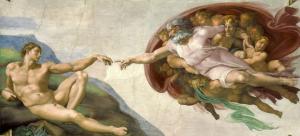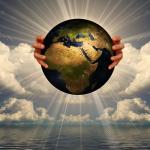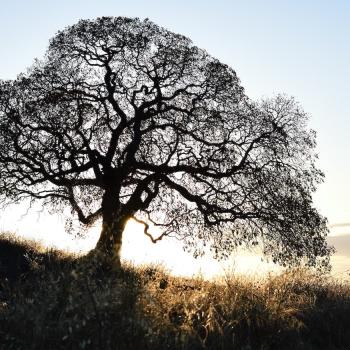The above phrase is commonly cited in a number of religious traditions, with a number of interpretations — from that of a pale imitation of the Creator, to a creature with a moral and intellectual capacity — and further, one that can make free will choices and bear responsibility for them.
Yet in the Judeo-Christian bible, the Hebrew term translated as “image” (tselem and variations) has several other uses: A phantom, illusion, resemblance, a representative figure, an idol (Strong’s Exhaustive Concordance 6754).
Accordingly, rather than humans created “in” the image of God, another interpretation might hold that humans were created as the image of God. In other words, in order to interface with an entity or power that is transcendental, unknowable, and ineffable, representative agents might be required to bring such power down to visible, comprehensible human scale.
Children of God
Another phrase or meme frequently encountered in many religious traditions is the characterization of followers as “children of God” — sometimes accompanied by the implication of “wayward” children who need to be reigned in, disciplined, and managed. Followers are often encouraged to distrust their own natural instincts and inclinations and instead become dependent on guidance from a parental deity-figure — generally as interpreted by teachers and church leaders.
Yet following the analogy further, it is not in the nature of children to eventually grow up and (ideally) become responsible adults? Few would consider it a parenting success if a 40 year-old child were afraid to make any independent choice or decision without first calling for permission and guidance.
Representative Agents
Regardless of one’s metaphysical beliefs about origins, whatever power, source, or entity was responsible for existence, it stands to reason that the fundamental nature of any existent thing would reflect, at least in part, the essence of that source.
A phrase often heard in the spiritual community attended by this writer characterizes individual existence as “fractals of divinity” — or “bite-sized pieces of God”. To that extent, it seems we would individually and collectively share some of the co-creative power and responsibility that we like to attribute to God (however we understand him/her/it). In other words, if we are each a little bit divine, we are at least partially responsible for creating the reality that we live in. To the extent that is so, what kind of reality do we want to be creating?
As illustrated by two recent books: “The Case Against Reality – Why Evolution Hid the Truth From Our Eyes” (Donald Hoffman) and “The Grand Biocentric Design” (Robert Lanza), increasing attention is being paid to the notion that consciousness (rather than energy and matter) is the primary, fundamental factor in the universe — or at least in our experience of reality. (Note: neither author is writing from a religious perspective. One is a physicist, the other an M.D.)
A central point in both books is that our experience of a world “out there” is largely an inherited, enculturated, learned response of our brain “in here”. (A striking but easy example: there is no actual ‘color’ in the world – nothing is inherently green or red or blue. Physical objects simply reflect various wavelengths of light. The color experience is then symbolically generated in the brain, since the brain can’t easily measure wavelengths of electromagnetic energy.)
A Choice Among Possibilities
Both of the above books also go on at length on the topic of Quantum Physics/Mechanics. QM holds that at the quantum scale, phenomena like electrons and quarks by default exist in a “cloud” of possibilities, and do not “collapse” to a definite, fixed state until actively observed by a conscious observer. Each book further attempts to show how this principle extends up to the scale of daily reality as we experience it.
A century ago psychologist William James observed that: “On whatever you place your attention, that becomes your reality.” The implication is that there is creative power in what we choose to attend to.
While it may be several centuries before we humans learn how to “move mountains” or “turn water into wine” or otherwise affect the physical world purely with our thoughts, we certainly do have influence over the social and psychological worlds that we create and dwell within. This is done to a large degree by what we value and where we focus our attention (remember the QM “observer effect”).
Down through the millennia, humans have applied thoughts toward creating benign realities that enable us to produce a vast range of goods and services, cure disease, pass on acquired knowledge, and connect the planet. However, not being fully aware of our co-creative power and responsibility, we also have created realities not so benign — through unconscious impulses to hoard resources and to divide, compete, control, and dominate others and the natural world.
Throughout history, these latter motivations have manifested in the realities of suffering, fear, and death for vast numbers of people. If we choose to continue in our spiritual evolution — to become reflective agents of divinity — do we at some point turn away from these dynamics, allowing them to sink back into the realm of the un-manifest? If our ultimate destination is a state of spiritual unity and one-ness, focusing energy and attention on “othering” and exclusion will only delay our progress.
Global crises on a range of fronts suggest that we are nearing an existential inflection-point. The spiritual, social, and economic worldview of self-interest/tribal-interest that has guided us to date appears to be reaching its limits. The time may now be ripe to leave childhood and take up the role and responsibilities of a spiritual adulthood, placing our co-creative attention and efforts upon that which seeks benefit for the whole of creation — of which we are all an integral part.
If there is an “image” of God, I’ll go with that one.
Image: Michelangelo, Public domain, via Wikimedia Commons













